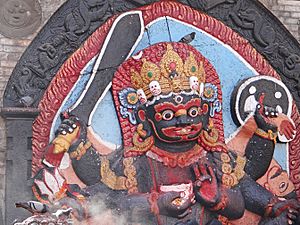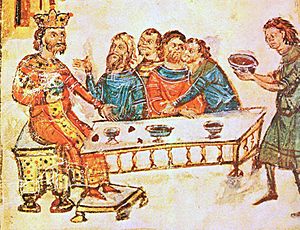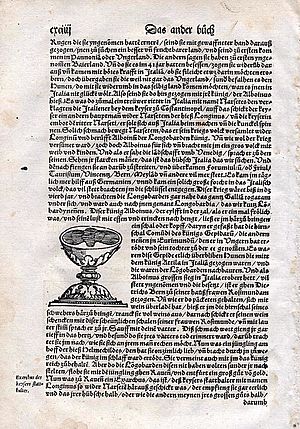Skull cup facts for kids
A skull cup is a special kind of drinking cup or bowl. It is made from the top part of a human skull. People have used skull cups for a very long time, in different cultures and for different reasons. Sometimes they were used in important ceremonies or as trophies. In Western cultures, they are often linked to ancient groups of people who moved around a lot, like those from the Eurasian Steppe.
The oldest skull cup found is about 14,700 years old. It was discovered in Gough's Cave in Somerset, England. Scientists can tell if a skull was used as a cup because it has marks from where flesh was removed. It also shows signs of being shaped to make a smooth edge for drinking.
Skull Cups in Asia
One of the earliest stories about skull cups in China comes from around 453 BC. After a big battle, the winners made a wine cup from the skull of their enemy.
Later, ancient records tell us about the Xiongnu people in what is now Mongolia. Around 162 BC, a Xiongnu leader named Laoshang killed the king of the Yuezhi people. Following their custom, he "made a drinking cup out of his skull." This skull cup was even used later when the Xiongnu made a peace agreement with Chinese ambassadors. Both sides drank blood from the cup to seal their promise.
In India and Tibet, skull cups are called kapalas. They are used in special religious ceremonies in Buddhism and Hinduism. For these uses, the skull does not come from an enemy. The identity of the person the skull belonged to is not important. Some Hindu gods, like Kali, are shown holding a kapala. Many old and decorated kapalas still exist, especially in Tibet.
In 1510, a ruler named Shah Ismail I defeated and killed Muhammad Shaybani in battle. Muhammad Shaybani was the founder of an empire in Uzbekistan. Shah Ismail I had Shaybani's skull covered in gold and jewels to make a drinking goblet.
In Japan, a famous warlord named Oda Nobunaga fought many battles in the 1570s. After winning two important sieges in 1573, he took the skulls of three enemy leaders. These were Azai Nagamasa, his father Azai Hisamasa, and Asakura Yoshikage. Nobunaga had parts of their skulls made into sake cups. Unlike other skull cups that looked like bowls, these Japanese cups were shallow, saucer-shaped pieces cut from the top of the skull. They were then covered in gold leaf and lacquer. Nobunaga used these cups to drink sake with his followers. This was a way to show what happened to those who went against him. These skull cups were likely lost when Azuchi Castle was destroyed in 1582.
Skull Cups in Europe
Ancient Greek historians like Herodotus and Strabo wrote about the Scythians. They said that the Scythians would kill their enemies and turn their skulls into drinking cups.
Another story from 216 BC tells of the Boii, a Celtic tribe in Europe. They also used skull cups in their ceremonies.
According to an old book called Historia Langobardorum, a Lombard king named Alboin defeated his enemies, the Gepids, in 567 AD. He killed their king, Cunimund, and made a drinking cup from his skull. He then took Cunimund's daughter, Rosamund, as his wife.
The leader of the First Bulgarian Empire, Khan Krum, was also said to have made a jeweled cup from the skull of the Byzantine emperor Nicephorus I. This happened in 811 AD after Krum killed the emperor in battle.
An old Russian history book, the Primary Chronicle, mentions a skull cup from 972 AD. It says that the skull of Svyatoslav I of Kiev was made into a chalice by a Pecheneg leader named Kurya. Kurya likely did this as a sign of respect for Svyatoslav. Stories say that Kurya and his wife drank from the skull and wished for a son as brave as the Rus warlord.
A legend says that after the pirate Blackbeard was killed in 1718, his skull was made into a drinking cup.
In 19th century Britain, the famous poet Lord Byron used a skull as a drinking vessel. His gardener found the skull at Newstead Abbey. Byron believed it belonged to a monk from the Abbey. He sent it away to be polished and made into a cup. Byron even wrote a poem about it called "Lines Inscribed upon a Cup Formed from a Skull." He and his friends would drink claret wine from the cup, pretending to be like ancient Goths.
See also
 In Spanish: Copa de cráneo para niños
In Spanish: Copa de cráneo para niños




